Beef with prunes braised
 4 servings
4 servings1 hour 40 min
In the recipe for braised beef with prunes, there is both a slight sourness and a sweetness of plums, and a barely tangible note of spicy cinnamon.
Beef - 500 gr, Water - 300 ml, Prunes - 200 gr, Tomato paste - 2 tbsp, Vegetable oil - 3 tbsp, Ground black pepper - to taste, Salt - to taste
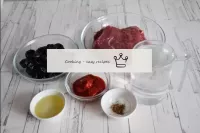 How to put out beef with prunes? Prepare the ingredients. If your meat was frozen, then defrost it first, transferring it from the freezer to the bottom shelf of the refrigerator. Prunes are better suited to sweet, pitted. Of the spices, I only used salt and pepper, but you can also add any others to your taste. Tomato paste can be replaced with grated fresh tomatoes, previously blanched and peeled.
How to put out beef with prunes? Prepare the ingredients. If your meat was frozen, then defrost it first, transferring it from the freezer to the bottom shelf of the refrigerator. Prunes are better suited to sweet, pitted. Of the spices, I only used salt and pepper, but you can also add any others to your taste. Tomato paste can be replaced with grated fresh tomatoes, previously blanched and peeled. 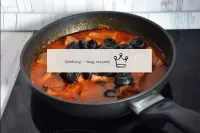 Put the prunes in the pan, mix. Simmer for another 10-20 minutes until the meat is ready - it should be soft. Top up with a little boiling water if needed. There should be some gravy left in the pan at the end of the simmer. The extinguishing time will depend directly on what beef you had, its quality and the part of the carcass from which the piece is taken.
Put the prunes in the pan, mix. Simmer for another 10-20 minutes until the meat is ready - it should be soft. Top up with a little boiling water if needed. There should be some gravy left in the pan at the end of the simmer. The extinguishing time will depend directly on what beef you had, its quality and the part of the carcass from which the piece is taken. Note that the quality and taste of the finished dish largely depends on the correct defrosting of the ingredients. How to avoid mistakes and choose the best way, read the article about defrosting.
Beef can be replaced with any other type of meat you like best. But keep in mind that the cooking time, as well as the taste and calorie content of the dish, will change. Pork and lamb are generally fatter than beef, and chicken fillet or turkey are more lean. At the same time, the cooking time depends not only on the type of meat, but also on how much of the carcass is used and how old or young the meat is.
For cooking, it is better to use taste-neutral filtered or bottled water. If you use tap water, keep in mind that it can give the dish an unpleasant characteristic taste.
 Español
Español Français
Français Português
Português Русский
Русский 简体中文
简体中文 繁體中文
繁體中文 日本語
日本語 한국어
한국어 العربية
العربية Türkçe
Türkçe Қазақ
Қазақ Deutsch
Deutsch Italiano
Italiano Українська
Українська
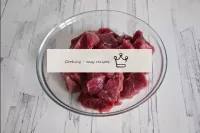 Wash the beef and be sure to dry with a paper towel, otherwise excessive moisture will prevent it from frying. Cut the meat into medium cubes.
Wash the beef and be sure to dry with a paper towel, otherwise excessive moisture will prevent it from frying. Cut the meat into medium cubes. 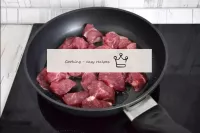 Heat the vegetable oil in a frying pan. Put the beef in the pan. Fry it over a medium heat, stirring with a spatula, until all the released juice has evaporated.
Heat the vegetable oil in a frying pan. Put the beef in the pan. Fry it over a medium heat, stirring with a spatula, until all the released juice has evaporated. 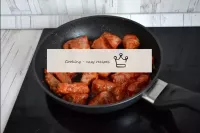 Add the tomato paste and stir quickly.
Add the tomato paste and stir quickly.  Pour water into the pan so that the liquid almost completely covers the meat. Bring it to a boil, reduce the heat to a minimum. Simmer the meat under the lid for about 1 hour.
Pour water into the pan so that the liquid almost completely covers the meat. Bring it to a boil, reduce the heat to a minimum. Simmer the meat under the lid for about 1 hour. 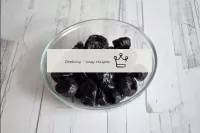 Prepare prunes. Wash it thoroughly and dry it. It is better to take large prunes without seeds - it has more sweetness and less sourness.
Prepare prunes. Wash it thoroughly and dry it. It is better to take large prunes without seeds - it has more sweetness and less sourness. 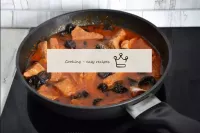 At the very end, salt and pepper the beef with prunes. Stir everything and remove the pan from the heat. The dish, in principle, does not require an additional side dish - prunes do an excellent job of this role. But if you wish, you can serve a stew with mashed potatoes or pasta.
At the very end, salt and pepper the beef with prunes. Stir everything and remove the pan from the heat. The dish, in principle, does not require an additional side dish - prunes do an excellent job of this role. But if you wish, you can serve a stew with mashed potatoes or pasta. 